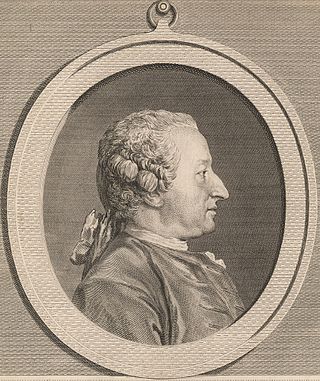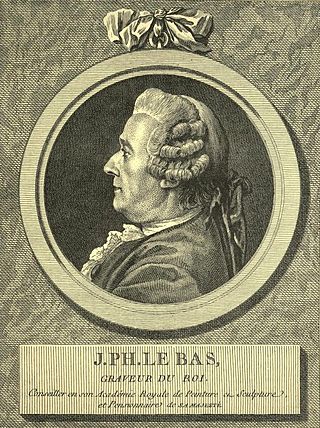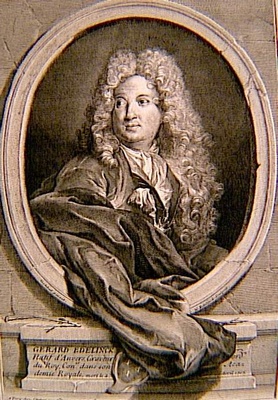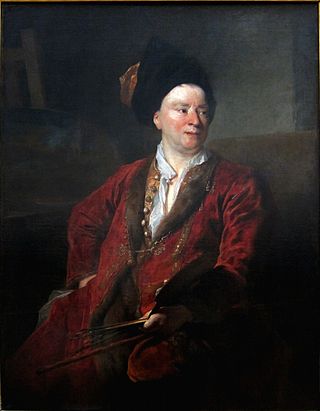
Nicolas Lancret was a French painter. Born in Paris, he was a brilliant depicter of light comedy which reflected the tastes and manners of French society during the regency of the Duke of Orleans and, later, early reign of King Louis XV.

Charles-Joseph Flipart (1721–1797) was a French painter and engraver.

Michael Bryan was an English art historian, art dealer and connoisseur. He was involved in the purchase and resale of the great French Orleans Collection of art, selling it on to a British syndicate, and owned a fashionable art gallery in Savile Row, London. His book, Biographical and Critical Dictionary of Painters and Engravers, first published in 1813–1816, was a standard reference work throughout the 19th century, and was last republished in 1920; however it is now badly outdated.
Bernard Baron was a French engraver and etcher who spent much of his life in England.

Nicolas Baudesson, a French flower painter, was born in Troyes in 1611, and was admitted into the Académie royale de peinture et de sculpture on May 26, 1671. He died at Paris in 1680, leaving a son, Jean François Baudesson, born in Paris in 1640, who was also a painter of flowers and fruit. The younger Baudesson became a member of the Academy in 1689, and died in Paris in 1713. Much of his work is in the Château de Versailles.

Henri Bonnart was a French painter and engraver. He was born in Paris in 1642, became rector of the Académie de Saint-Luc, and died in Paris in 1711. Le Blanc attributes to him 201 plates, of which 20 are religious subjects, 46 portraits, and 135 costume prints.

Antoine Bouzonnet-Stella was a French painter and printmaker, a pupil and nephew of Jacques Stella.

Claudine Bouzonnet-Stella was a French engraver, most of whose prints were after works by Nicolas Poussin, or by her uncle Jacques Stella, from whom she received her artistic education.

Antoine-Laurent Castellan (1772–1838) was a French painter, architect, and engraver.

Louis-Jacques Cathelin (1738–1804) was a French engraver.

François Chéreau, also known as François I Chéreau was an engraver of portraits and reproductions of famous works of art during the reign of Louis XIV.

Pierre-Philippe Choffard was a French draughtsman and engraver.

Charles Nicolas Cochin the Elder was a French line-engraver.
Nicolas Cochin (1610–1686), called the Elder, was a French draughtsman and engraver. He was born at Troyes in 1610, the son of a painter named Noel Cochin. About 1635, he went to Paris, where he died in 1686. He often imitated and copied Jacques Callot, but chose for his model Stefano della Bella, some of whose drawings he engraved. Like these two artists he excelled in small figures, which he grouped and delineated with lifelike animation. His specialty was topography, including battles, sieges, and encampments. He engraved several hundred subjects, the most important of which are those he executed for the "Glorieuses Conquêtes de Louis le Grand", called the "Grand Beaulieu", published between 1676 and 1694. The best of these plates may be the "Siege of Arras", engraved on 16 plates by Cochin and Jean Frosne.

Simon de Vries, also known as Simon Frisius, was a Dutch engraver.
Gaspard Duchange (1662–1757) was a French engraver.

Nicolas-Étienne Edelinck was a French engraver, was born to a family of engravers in Paris, the eighth son of Gérard Edelinck. Although he had the advantage of his father's instruction, and of studying in Italy, he never rose above mediocrity. He engraved some portraits, and a few plates for the Crozat Collection. He died in Paris in 1768. Among other prints by him are the following:

Nicolas Henri Joseph de Fassin was a landscape painter from Liège in the Southern Netherlands. Early in life he served in the French army, and it was not until he was thirty-four years of age that he commenced the study of art in the Academy at Antwerp. He afterwards visited Italy and Switzerland, and resided for some time at Geneva. He painted a landscape for Catherine the Great, for which he was handsomely rewarded, and many others are to be found at Liège, and in Germany and England. He died in his native city in 1811. His biography, with a list of his pictures, was published by Félix Alexandre Joseph Van Hulst in 1837.

Jean-Baptiste Forest was a French landscape painter.
Nicolas-Auguste Galimard was a French historical, portrait and landscape painter.

















